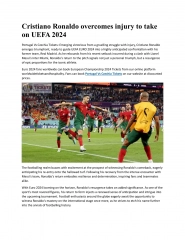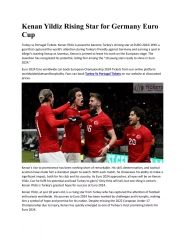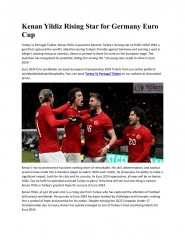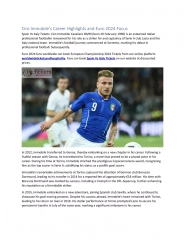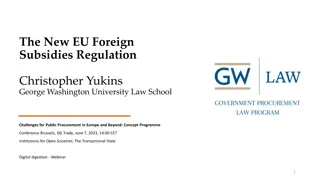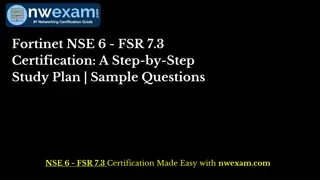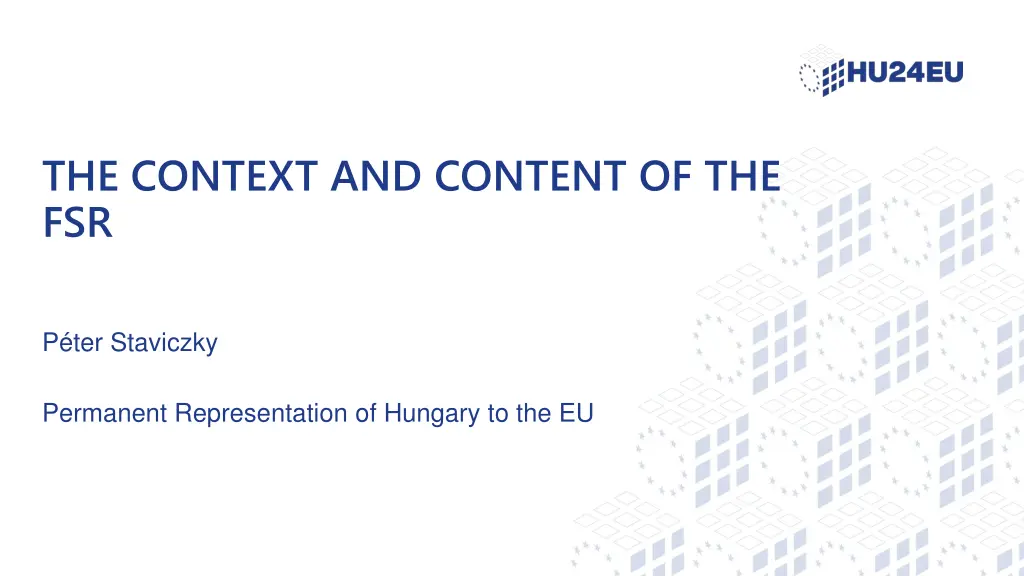
Understanding the Framework for Foreign Subsidy Regulation
Explore the context, background, and objectives of the Foreign Subsidy Regulation (FSR) within the EU, focusing on the need to address distortions caused by foreign subsidy measures to ensure a level playing field in the internal market. Learn about the emergence of new regulatory tools, trade challenges, and the concept of foreign subsidies in the evolving international trade landscape.
Download Presentation

Please find below an Image/Link to download the presentation.
The content on the website is provided AS IS for your information and personal use only. It may not be sold, licensed, or shared on other websites without obtaining consent from the author. If you encounter any issues during the download, it is possible that the publisher has removed the file from their server.
You are allowed to download the files provided on this website for personal or commercial use, subject to the condition that they are used lawfully. All files are the property of their respective owners.
The content on the website is provided AS IS for your information and personal use only. It may not be sold, licensed, or shared on other websites without obtaining consent from the author.
E N D
Presentation Transcript
THE CONTEXT AND CONTENT OF THE FSR P ter Staviczky Permanent Representation of Hungary to the EU
THE CONTEXT EU is a customs union and based on the internal market The IM needs protection form threats originating from outside Common EU trade policy (EU COM) WTO rules are setting the broader framework EU is the biggest promoter of fair international trade and multilaterism Recently, challenges appeared against this approach from different actors The EU had to redefine its interests and how to protect them The pandemic, wars and the sanctions also changed the landscape Emergence of China at international level What is the new normal and how to adhere to it? A chain of legislative processess started some years ago
THE CONTEXT Introduction of new regulatory tools application of the existing ones FDI screening since 2020 IPI restriction of access to procurement markets 2023 CBAM new EU resource + reply to carbon leakage 2023 Anti coercion rules 2023 Still using traditional trade defence tools against subsidised imports (BEV procedure, ex officio)
OBJECTIVE AND BACKGROUND OF THE FSR To fill the regulatory gap, and protect the internal market from undue distortions coming from third countries WTO, State aid, Anti Subsidy-/ Andti-dumping rules does not cover all cases, situations, effects Legal basis: TFEU Articles 114 approximation of law - harmonization, 207 common commercial policy Competition law powers vested under different articles of the TFEU Commission is the enforcer
FSR IN GENERAL Objective proper functioning of the internal market, address distortions caused by foreign subsidy measures, level playing field Application and interpretation in line with existing EU law, State aid, mergers, public procurement Similar wording, attempt to be close 5
CONCEPT OF FOREIGN SUBSIDY Definition of foreign subsidy Undertaking engaged in economic activity Foreign financial contribution (state resource/accountability) from a third State (or SOE) directly or indirectly Benefit (advantage- directly/indirectly) Selectivity - specificity 6
CONCEPT OF FOREIGN SUBSIDY Foreign financial contribution (in any form whatsoever) (a) the transfer of funds or liabilities, such as capital injections, grants, loans, loan guarantees, fiscal incentives, the setting off of operating losses, compensation for financial burdens imposed by public authorities, debt forgiveness, debt to equity swaps or rescheduling; (b) the foregoing of revenue that is otherwise due, such as tax exemptions or the granting of special or exclusive rights without adequate remuneration; or (c) the provision of goods or services or the purchase of goods or services 7
CONCEPT OF FOREIGN SUBSIDY Grantors a) the central government and public authorities at all other levels; b) a foreign public entity whose actions can be attributed to the third country, taking into account elements such as the characteristics of the entity and the legal and economic environment prevailing in the State in which the entity operates, including the government s role in the economy; or c) a private entity whose actions can be attributed to the third country, taking into account all relevant circumstances 8
CONCEPT OF FOREIGN SUBSIDY Distortion: effective or liability to improve the competitive position, potential negative effects on EU companies Indicators (open list) Amount Nature Recipient s situation, sector Evolution of the activity Conditions attached, purpose Presumption: amount 4 EUR million / 3 years unlikely to distort De minimis amount (currently EUR 300.000 / 3 years): no distorting effect Damage compensation after disasters: no distortion 9
CONCEPT OF FOREIGN SUBSIDY The most distortive subsidies For ailing undertakings without restructuring plan Unlimited guarantees (amount and duration) Export measures outside the OECD Agreement s scope Direct facilitation of concentration Allowing to submit unduly advantageous tender Recipient can explain 10
CONCEPT OF FOREIGN SUBSIDY Balancing: positive and negative effects by COM, EU objectives, just like under Art. 107 (3) TFEU No presumtion of effect Negative effect on the market and on future markets Decision about whether to impose redressive measures, accept committments, based on their nature and level State aid law 11
PROCEDURES 1.Ex officio 2.Mergers 3.Public procurements Notification obligation for Undertakings above thresholds 12
EX OFFICIO REVIEW COM s decision (may), implementing act adoption with prior discussion with the MS Any source of information can be a basis As regards already awarded public procurements, no cancellation or termination of the award Two-phase procedure: preliminary review and in-depth investigation Existence of subsidy: request for information, inspections Information to MS, contracting authority/entity Sufficient indication about foreign subsidy & distortion in-depth phase Informing the recipient and the MSs concerned, publication a notice in the OJ 13
EX OFFICIO REVIEW In-depth investigation Seeking information Decision to impose redressive measures in case of distortions Acceptance of offering committments by the recipient by a decision No objection decision: not confirmed situation, positive impacts outweigh the negative effects 18 months indicative time limit Interim measures To preserve the competition and act against irreparable damage Sufficient indication is necessary as regards the existence and distortion Might be limited in time Open list 14
EX OFFICIO REVIEW Requests for information From the undertaking From other undertakings, associations From Member States Third country (?) Interviewing natural or legal persons Inspections (dawn raids) Undertakings premises Books, records Asking representatives Seal business premises Cooperation or the lack of it Juridical supervision Cooperation with the MS, authorities Art 4 (3) TEU on loyal cooperation 15
EX OFFICIO REVIEW Inspections outside of the EU Informing the third country and no objection Non-cooperation Refusal to give information, misleading, false information, incomplete information, impeding the COM action Presumtion of benefit if the SOE does not cooperate Facts available to be used Fines and periodic penality payments 1% preceeding year s turnover fine 5% periodic penalty, daily aggregate turnover, until submitting complete & correct answer Infringement of committments, interim measures, redressive measures: 10% & 5% Assesment of the gravity, duration, proportionality Possibility of reduction of periodic penalty payments, in case of cooperation 16
PUBLIC PROCUREMENT TOOL Foreign subsidy can enable unduly advantageous tender Procedure-specific assessment Three years backwards looking Scope: EUR 250 million estimated value net of VAT, framework agreements and dynamic purchasing systems also covered, and The bidder and its subsidiary, main subcontractors and suppliers received EUR 4 million per third country in the last three years EUR 125 million in case of procurement divided into lots Defence and security procurement under Directive 2009/81 are excluded If only one supplier is able to provide: information no notification Contracting authority / entity shall remind in the notice about the notification obligation 17
PUBLIC PROCUREMENT TOOL Above the thresholds: notification obligation to the contracting authority / entity about all foreign financial contribution (3 years) List with declaration, if not notifiable due to the size Both submitted together with the tender Multi-staged procedure, submission twice, also when interest to participate is shown Contracting authority / entity transfer all documents to the COM without delay , notice contains information about the notification obligation, obligation of CA/E to check unduly advantageous (abnormally low tenders) Missing documentation: 10 days to submit asked by the CA/E Info to COM is not provided by tenderer but suspicios, COM can act before the award 18
PUBLIC PROCUREMENT TOOL COM assessment without undue delay Missing info: request to CA/E and the operator concerned 10 working days to complete Still missing info: irregularity declared by the COM in a decision rejection at national level requested by the COM Obligation to notify applies to: economic operators, groups of them, main subcontractors and main suppliers known when the submission is made >20% value or key elements provided Main contractor or concessionaire has to ensure notification / declaration Responsible of the veracity of the data only in respect of its own foreign financial contributions 19
PUBLIC PROCUREMENT TOOL General procedural rules apply Preliminary review 20 working days after receiving complete notification COM may extend once with 10 working days Multi-stage procedures: 20 working days assessment supsension depending on the participation additional 20 working days Decision about the in-dept investigation within this time limit informing the CA/E and economic operator without delay Missing information: COM may request additional information time limits from the new submission ex officio avenue is also open In-depth investigation 110 working days May be extended once with 20 working days after consultation with the CA/E 90 days for multi-stage procedures from the complete notification 20
PUBLIC PROCUREMENT TOOL Commission decisions after in-dept investigation If benefit from a foreign subsidy distorts the internal market Committments from the economic operator assessed whether fully and effectively remedy the distortion: conditional decision (implementing act) listing the committments If no committments proposed / the committments are not appropriate or sufficient according to the COM: decision to prohibite the award (CA/E rejects the tender), negative decision Decision finding no benefit / no distortion positive decision (no aid decision) COM assessment cannot modify the tender 21
PUBLIC PROCUREMENT TOOL Procedural questions How to interfere the least with the procurement procedure and decision-making? During preiminary review: all steps can be taken except the award of the contract In case of in-depth investigation: no award for the economic operator submitting notification until the time limits elapse, afterwards awarding is possible Most advantageous offer submitted by operator sending declaration & no review by COM: awarding is possible even before the time limits elapse or COM takes decision Negative COM decision & most advantageous offer: awarding to the second best No aid decision: award is possible also to the operator submitting a notification 22
STATE OF PLAY: EX OFFICIO TOOL Two ongoing investigations in preliminary review phase In the wind sector: Requests for information sent on 9 April to Chinese wind turbine manufacturers and to developers of wind parks in Spain, Greece, France, Romania and Bulgaria Investigation may be widened to other wind energy projects and companies, based on information received meanwhile In the threat detection sector (Nuctech): Unannounced inspections conducted in the period 23 26 April in Poland and the Netherlands First dawn raid under the FSR interim measures denied: T-284/24 R Work in close cooperation with relevant authorities in the two Member States National rules required & procedures in place to support the Commission and cooperate In case of sufficient indications of distortive foreign subsidies, the Commission will launch an in-depth investigation. If not, the preliminary review will be closed
STATE OF PLAY: CONCENTRATION TOOL Notification obligation started to apply on 12 October 2023 91 prenotifications 58 notified cases 50 closed cases all closed after preliminary review Cases in a variety of sectors Large majority of cases also notifiable under EUMR, and also a few under national merger review Roughly 1/3 of the cases are subject to at least one national FDI screening procedure
CONCENTRATION CASE 10/06/2024 Emirates Telecommunications Group Company PJSC ( e& ) from UAE of sole control of PPF Telecom Group B.V. except CZ company (Czechia, Bulgaria, Hungary, Serbia (Yettel) and Slovakia (O2).) Unlimited state guarantee, explicitly mentioned in Art 5. as distorting the internal market Loan with State origin Negative effect - outbid others Decision until 15 October (+20 days poss.) MS involved in Advisory Committee meeting, including vote on committments
THE PUBLIC PROCUREMENT TOOL First case on the CRRC BG procurement, train manufacturing, electric push-pull trains as well as related maintenance and staff training services Unduly advantageous tender? Contract value 610 m, offer much cheaper than second best bidder COM: initiated Phase II no all information was part in the notification, State owned enterprise Company withdrew its bid, case closed without decision
IN THE LEGISLATIVE PIPELINE Export controls 24.01.2024. White Paper, stronger and more harmonized controls, stronger EU voice Adhere to CFSP, sanctions and trade policy objectives White paper on outbound investments Limiting the leak of sensitive technologies, and security risks Monitoring and risk assessment Promoting further discussions on how to better support research and development involving technologies with dual-use potential; Proposal that the Council recommends measures aimed at enhancing research security at national and sector level Revision of the FDI Screening Regulation
CONCLUSIONS Deglobalization, de-risking Sanctions Strategic autonomy Usual EU reply to challenges: legislation, revision, new procedures, coordination, update, etc. Slow, but it works, if the EU has proper and targeted safeguards, manpower needed, feedbacks are important More complex legislative landscape, multiple procedures more compliance costs for undertakings, heaven for lawyers and advisors Geopolitical changes can have an impact FSR case practice to be developed in the coming years




